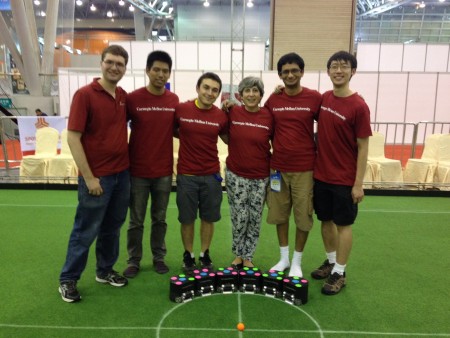 Carnegie Mellon University’s robot soccer team took home its fifth world championship without allowing a single goal at the 2015 RoboCup on July 22 in Heifi, China.
Carnegie Mellon University’s robot soccer team took home its fifth world championship without allowing a single goal at the 2015 RoboCup on July 22 in Heifi, China.
The CMDragons won the final round of the Small Size League (SSL) 5-0 over MRL, a team from Qazvin Islamic Azad University in Iran.
“An accomplishment of this nature requires an extremely high level of team commitment and discipline, in terms of ideas and software development. I have worked with RoboCup teams for many years, and this year’s students were extremely engaged,” said Manuela Veloso, the Herbert A. Simon University Professor in the School of Computer Science. Veloso advises the team and helped to launch the Robot World Cup Initiative, or RoboCup for short, in 1997.
SSL, one of five RoboCup Soccer leagues, focuses on challenging problems facing artificial intelligence and robotics. Teams must develop robots capable of performing at a high level individually while coordinating with one another and adapting to an uncertain, adversarial, constantly changing, fast-paced environment.
Two teams of six robots, each less than six inches high, play with an orange golf ball on a field of predefined size with line markings. Color-coded patterns on top of each robot enable a set of overhead cameras, running a shared algorithm, to determine the position and orientation of each robot. Off-field computers are used to communicate referee commands and team strategies.
Joydeep Biswas, a computer science post-doctoral fellow and recent graduate of the Robotics Institute’s doctoral program, and Juan Pablo Mendoza, a Robotics Institute doctoral student, led the team. Biswas and Richard Wang, a computer science doctoral student, specialized in hardware development and enhanced the team’s original robots, created by former CMU researcher Mike Licitra.
Robotics Institute doctoral student Philip Cooksey and Biswas developed the individual motion execution and ball-kicking and dribbling capabilities of the robots, while Mendoza, Wang and computer science master’s degree student Steven Klee focused on robot collaboration.
“Our consistent, aggressive multi-robot attack led to incredible multi-step passes and goals,” Veloso said. “Of the 48 points the CMDragons scored during the tournament, a vast majority was the result of continuous passes and aggressive rebound taking.”
The team developed the best algorithm Veloso has seen for “game on” play, which requires a higher level of adaptability than set plays teams use following ball stoppage.
In addition, computer science graduate student Danny Zhu developed an impressive defense that did not give up a single goal during the tournament. The CMDragons earned a spot in the final round by defeating the following teams: Parsian (6-0) from Amirkabir University of Technology in Iran, Warthog Robotics (10-0) from University of São Paulo in Brazil, KIKS (10-0) from Toyota National College of Technology in Japan, Tigers Manheim (15-0) from DHBW Manheim in Germany and STOx’s (2-0) from Universidad Santo Tomás in Colombia.
Veloso said the team’s remarkable care and maintenance of its robots enabled testing with multiple robots, in addition to exhaustive pre-tournament simulations made possible by a new automated game referee Zhu developed.
For more information about RoboCup 2015, visit http://www.robocup2015.org/.